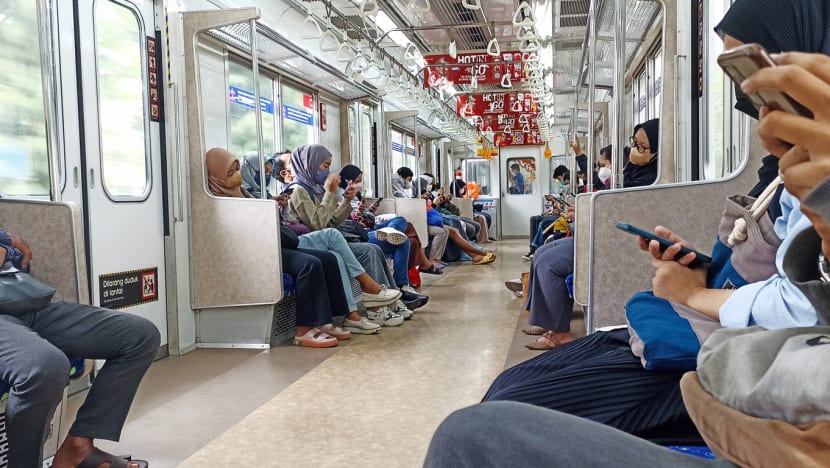Indonesia’s middle class population shrinks by close to 9.5 million people as experts warn against further drop
Coordinating Minister for Economic Affairs Airlangga Hartarto stressed the importance of the middle class population for Indonesia's economy, describing it as the driving force for economic growth.

People are seen using an electric train (KRL) in Jakarta, Indonesia. (Foto: iStock/@Budi Setiawan)
JAKARTA: A declining middle class population in Indonesia is ringing alarm bells in the country, analysts have warned, even as the government introduces a raft of measures aimed at supporting this group.
And the analysts further added that more support is needed to bolster this segment of the population to prevent a further drop.
According to the latest numbers from the Central Bureau of Statistics (BPS), the number of people classified as middle class has declined by close to 9.5 million in the past five years.
In 2019, the middle class population in Indonesia numbered at 57.33 million. BPS data shows that this has dropped to 47.85 million in 2024.
The World Bank defines those in the middle class as individuals whose expenditure each month - used as a proxy for income - range from 3.5 to 17 times above the poverty line, which BPS data equates to approximately 2 million rupiah (US$130) to 9.9 million rupiah per capita.
"The middle class population began to decline after the (COVID-19) pandemic, while the aspiring middle class increased," Acting BPS Head Amalia Adininggar Widyasanti was quoted by Kompas on Wednesday (Aug 28) as saying during a working meeting with the House of Representatives.
In line with the decrease in the number of people classified as middle class, the number of those classified as part of the aspiring middle class has increased within the same period of five years.
Those classified as part of the aspiring middle class segment of the population increased from 128.85 million in 2019 to 137.5 million this year. They form 49.22 per cent of Indonesia’s population.
Coordinating Minister for Economic Affairs Airlangga Hartarto said that these two segments make up about 66.6 percent of the country’s population, and stressed the importance of the middle class for Indonesia's economy, describing it as the driving force for economic growth.
In his speech at an economic dialogue on the role of the Indonesian middle class towards Golden Indonesia 2045 vision on Aug 27, Mr Airlangga stressed about the importance of strengthening the purchasing power of the poor as well as of the middle class and more importantly, the aspiring middle class.
The Golden Indonesia 2045 vision is a long-term plan which aims to make Indonesia an advanced and prosperous country by its 100th independence anniversary.
To support the middle class, Mr Airlangga said that the government has implemented various initiatives, including social protection programmes, tax incentives, the Pre-Employment programme, as well as the People's Business Credit scheme, among others.
One notable tax incentive, he said, is the government's plan to reinstate a full tax break on property purchases worth up to 5 billion rupiah for the second half of 2024.
This policy, which covers the cost of value-added tax on up to 2 billion rupiah of an eligible property's price, was previously reduced to a 50 percent rebate after the full coverage ended in June.
Mr Airlangga said that the policy change aims to bolster the purchasing power of the middle class, and has already received the approval of President Joko Widodo.
However, analysts said that beyond the lingering effects of COVID-19, other reasons that have contributed to a decline in Indonesia’s middle class population include weak national economic fundamentals, burdensome government policies, as well as the absence of a robust social safety net.
Mr Bhima Yudhistira, the executive director of the Center for Economic and Law Studies (Celios), said that the weak performance of the manufacturing sector is a significant factor in the shrinking middle class.
He told Kompas that the downturn in the manufacturing sector has led to widespread layoffs and the decline in the industry's share of the gross domestic product.
Since the beginning of 2024, the Indonesian Confederation of Workers Unions of the Archipelago has predicted that layoffs in the labour-intensive manufacturing sector could affect as many as 100,000 people.
Mr Bhima added that one government policy that has further strained the public’s purchasing power is the increase in the value-added tax (VAT) rate, which took effect on Apr 1, 2022.
"The VAT increase contributes to higher retail prices," Mr Bhima told Kompas, adding that the higher cost of living situation is further exacerbated by the lack of social safety nets for the middle class, since most of the government's focus is primarily on providing social assistance to the poor.
Meanwhile, economist Yusuf Rendy Manilet from the Center of Reform on Economics (Core) said that it is important for the government to begin providing financial assistance to those in the middle class and aspiring middle class segments of the population.
“Whether in the form of cash transfers or subsidies, (these assistance) can be given to the middle- and aspiring middle class (population), or else the downward trend in the middle class may continue," Mr Yusuf said.













